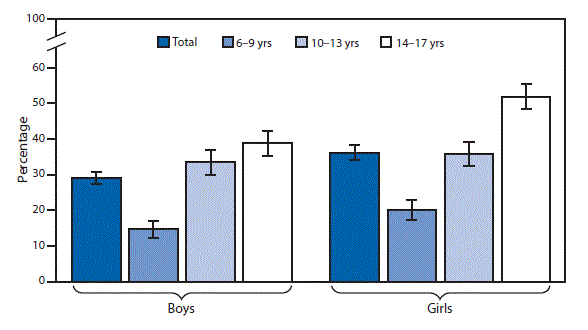QuickStats: Percentage* of Children Aged 6–17 Years Who Wear Glasses or Contact Lenses,† by Sex and Age Group — National Health Interview Survey, 2016§
Weekly / September 1, 2017 / 66(34);917
Please note: An erratum has been published for this report. To view the erratum, please click here.

* With 95% confidence intervals indicated with error bars.
† Based on the survey response of “yes” to the question “Does (child’s name) wear eyeglasses or contact lenses?” Children who are blind were excluded from these estimates.
§ Estimates are based on household interviews of a sample of the civilian, noninstitutionalized U.S. population and are derived from the National Health Interview Survey Sample Child component.
In 2016, the percentage of children aged 6–17 years who wear eyeglasses or contact lenses was higher among girls (36.2%) compared with boys (29.1%). Girls aged 6–9 years (20.2%) and 14–17 years (51.9%) were more likely than boys of the same age group (14.9% and 38.8%, respectively) to wear eyeglasses or contact lenses. There was no statistically significant difference by sex for children aged 10–13 years (35.9% among girls, 33.5% among boys). Among both girls and boys, children aged 14–17 years were most likely to wear eyeglasses or contact lenses, and children aged 6–9 years were least likely to wear eyeglasses or contact lenses.
Source: National Center for Health Statistics. National Health Interview Survey, 2016. https://www.cdc.gov/nchs/nhis.htm.
Reported by: Lindsey I. Black, MPH, lblack1@cdc.gov, 301-458-4548.
Suggested citation for this article: QuickStats: Percentage of Children Aged 6–17 Years Who Wear Glasses or Contact Lenses, by Sex and Age Group — National Health Interview Survey, 2016. MMWR Morb Mortal Wkly Rep 2017;66:917. DOI: http://dx.doi.org/10.15585/mmwr.mm6634a7External
MMWR and Morbidity and Mortality Weekly Report are service marks of the U.S. Department of Health and Human Services.
Use of trade names and commercial sources is for identification only and does not imply endorsement by the U.S. Department of
Health and Human Services.
References to non-CDC sites on the Internet are
provided as a service to MMWR readers and do not constitute or imply
endorsement of these organizations or their programs by CDC or the U.S.
Department of Health and Human Services. CDC is not responsible for the content
of pages found at these sites. URL addresses listed in MMWR were current as of
the date of publication.
All HTML versions of MMWR articles are generated from final proofs through an automated process. This conversion might result in character translation or format errors in the HTML version. Users are referred to the electronic PDF version (https://www.cdc.gov/mmwr) and/or the original MMWR paper copy for printable versions of official text, figures, and tables.
Questions or messages regarding errors in formatting should be addressed to mmwrq@cdc.gov.